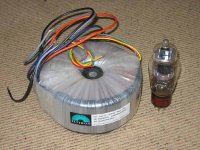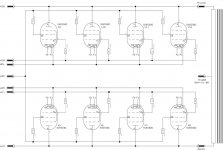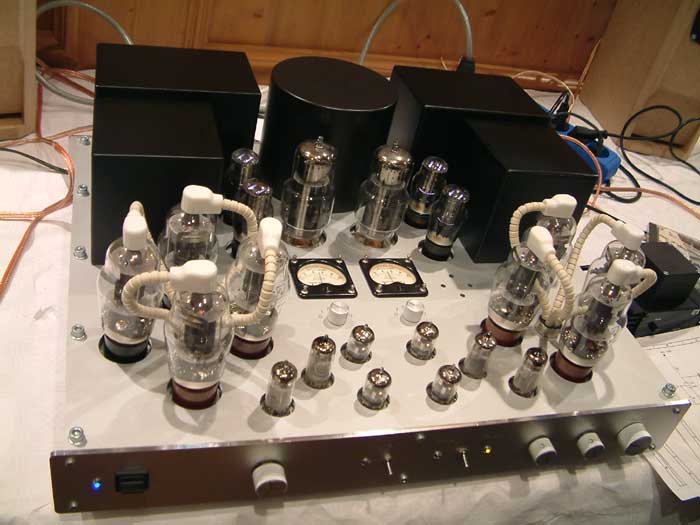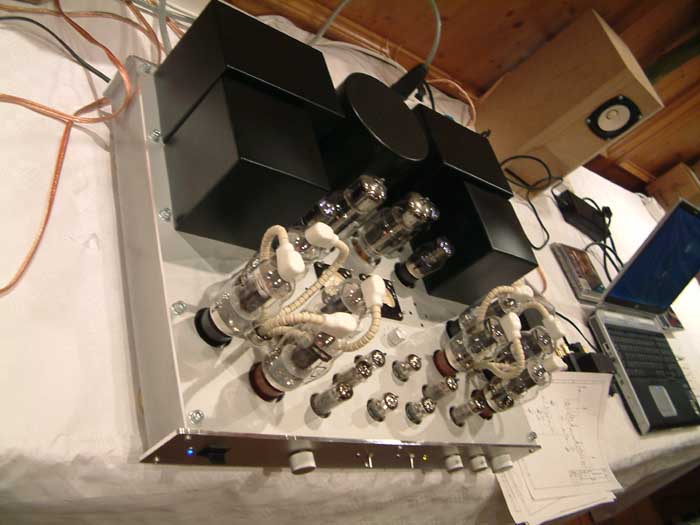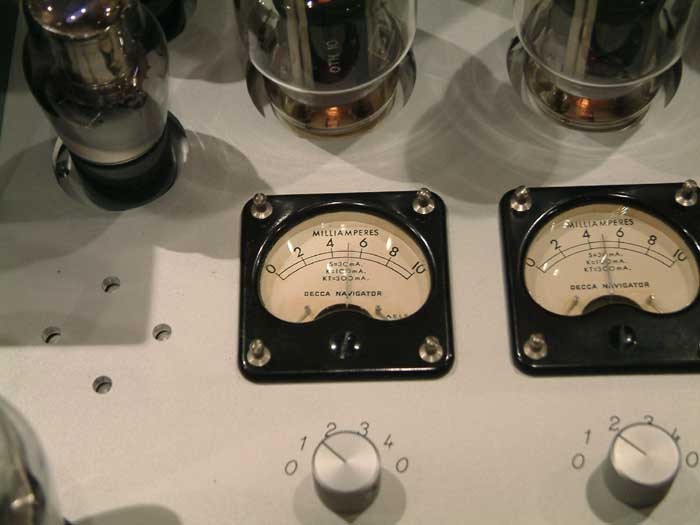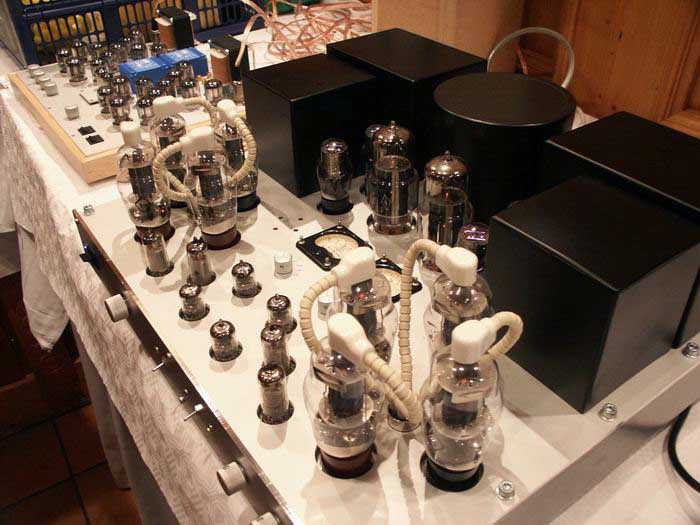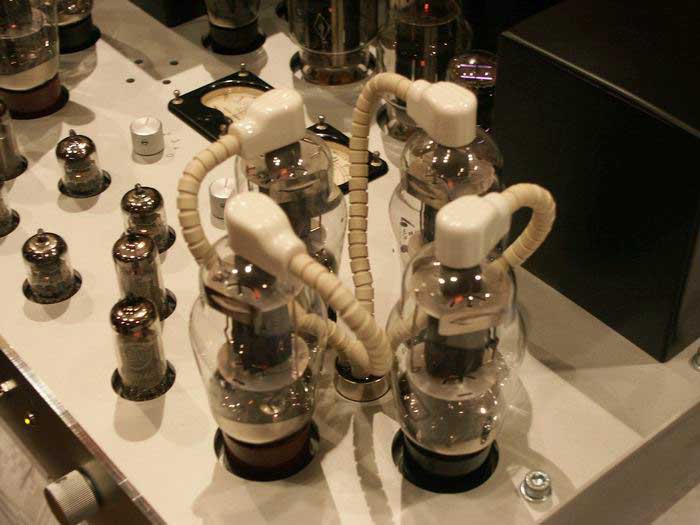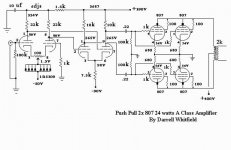I have recently developed a strong admiration for 807 tubes and I just acquired a large lot of them!
Can they be paralleled on a push pull output stage to drive a 1900 ohm primary impedance transformer AKA Hammond 1650T?
What valve pre stage is capable of driving such a large set of valves push pull?
Cheers,
Shawn.
Can they be paralleled on a push pull output stage to drive a 1900 ohm primary impedance transformer AKA Hammond 1650T?
What valve pre stage is capable of driving such a large set of valves push pull?
Cheers,
Shawn.
Tom,
The only way I know to use a transformer as an interstage, that will work with this sort of load, is to step the ratio down from the driver tubes. I use a 1.414 to 1 step down ratio for eight EL 34's in PP parallel triode connection. I also use two paralleled driver tubes in PP parallel triode, a pair of 7119's. Fine amplifiers.
Bud
The only way I know to use a transformer as an interstage, that will work with this sort of load, is to step the ratio down from the driver tubes. I use a 1.414 to 1 step down ratio for eight EL 34's in PP parallel triode connection. I also use two paralleled driver tubes in PP parallel triode, a pair of 7119's. Fine amplifiers.
Bud
TomWaits said:What valve pre stage is capable of driving such a large set of valves push pull?
Cheers,
Shawn.
If I was going to attempt something like this, I'd probably go with a MOSFET driver connected as a source follower. You're going to get a whole bunch of Cmiller that will require lots of drive current to charge it up fast enough to minimize the slew rate problem.
Anyway, I wouldn't do that. If you need lotsawatts, two 807's in Class AB2 will give some 80W with 3.5% THD without feedback. Two Class AB2 807's are a much easier load than eight in Class AB1, trioded.
If you have a whole bunch of 807's, sell some off and get the iron that'll work with this.
Hi Shawn,
807, like 6L6 is not particularly hard to drive when being used as a beam power tube. It is a little bit harder in triode mode, though, due to the Miller capacitance.
As mentioned already, driving them via a buffer (CF) is a sure fire way to go.
But, there is another feasible way: Just use a beefy LTP, f.e employing triode strapped 6V6 or EL84/6BQ5, which compares roughly to 4-5 6SN7 sections in parallel.
This way, a "Mullard" style amp could be done. Be aware, though, that an LTP using trioded EL84 or 6V6 would be a rather tough load to an EF86 based frontend, as being used in the Mullard circuit. I would suggest 6AU6 or something of its class instead, getting some decent curent going in the 1st stage.
Regards,
Tom
807, like 6L6 is not particularly hard to drive when being used as a beam power tube. It is a little bit harder in triode mode, though, due to the Miller capacitance.
As mentioned already, driving them via a buffer (CF) is a sure fire way to go.
But, there is another feasible way: Just use a beefy LTP, f.e employing triode strapped 6V6 or EL84/6BQ5, which compares roughly to 4-5 6SN7 sections in parallel.
This way, a "Mullard" style amp could be done. Be aware, though, that an LTP using trioded EL84 or 6V6 would be a rather tough load to an EF86 based frontend, as being used in the Mullard circuit. I would suggest 6AU6 or something of its class instead, getting some decent curent going in the 1st stage.
Regards,
Tom
http://www.plitron.com/shopping/shopexd.asp?id=626
why get Hammond when these 400w Plitron are sold as surplus?
why get Hammond when these 400w Plitron are sold as surplus?
why get Hammond when these 400w Plitron are sold as surplus?
I just couldn't say no. A 400 watt P-P toroidal OPT for $134 USD. Deal! Two transformers are on order, now I just need to figure out what to build. With 2 X 400 watt OPT's it will be big, and loud. Well I have a bunch of 807's, but I also have a bunch of big sweep tubes. Class B screen drive maybe?
tubelab.com said:I just couldn't say no.
I wrote Plitron for specs more detailed than primary impedance and size and they didn't say anything at all. Curious what you'll find.
That might well be the thing to do- with idle currents in the single digits of milliamps, DC imbalance (the thing that scares me about toroid OPTs) becomes less of an issue.
CCS in the cathodes keeps this under control, but I think it restricts you to class A (though I have seen it suggested that AB is possible). I am currently running this setup and am very happy with the results. Can be turned into a fully differential output stage.
Shoog
agent.5 said:why get Hammond when these 400w Plitron are sold as surplus?
WOW! That's funny...I just picked up two of those Plitron's a few weeks ago.
I'm almost certain these Plitron's were designed for a Marshall Bass amplifier. It will be interesting to see the frequency response from these.
Attachments
Re: Marshall
Not really. If I wanted that much power, I'd get a couple of 814's (807's DH big brother) and run them Class AB2. Getting that many VTs all pulling together will probably require a PIC-based bias circuit. There was a design out there ("The Emperor's New Amp"?) that used 4 PPP 6BQ5s, and that used coordinated integrator type bias stabilization.
Also, 807s require plate stoppers. These can sometimes be simply 100R resistors connected to the plate connectors. For that, I prefer the RF-style plate stoppers that consist of 10 (space wound) turns of #18 wire, D= 7/16ths inch, with the 100R/2W de-Q-ing resistor mounted inside the coils. That way, the coils represent a significant impedance at RF, but have no effect on AF operation.
I'm also not totally convinced that paralleling up a bunch doesn't have adverse sonic consequences.
TomWaits said:Output wiring:
You guys like this sorta thing for 8x 807's?
Cheers,
Shawn.
Not really. If I wanted that much power, I'd get a couple of 814's (807's DH big brother) and run them Class AB2. Getting that many VTs all pulling together will probably require a PIC-based bias circuit. There was a design out there ("The Emperor's New Amp"?) that used 4 PPP 6BQ5s, and that used coordinated integrator type bias stabilization.
Also, 807s require plate stoppers. These can sometimes be simply 100R resistors connected to the plate connectors. For that, I prefer the RF-style plate stoppers that consist of 10 (space wound) turns of #18 wire, D= 7/16ths inch, with the 100R/2W de-Q-ing resistor mounted inside the coils. That way, the coils represent a significant impedance at RF, but have no effect on AF operation.
I'm also not totally convinced that paralleling up a bunch doesn't have adverse sonic consequences.
How bad was the shipping?
"estimated" at $42 USD. I have used Plitron power transformers before, but this will be my first experiment with a "real" toroidal OPT. I was thinking of near class B operation to deal with the imbalance issue. Idle current imbalance is a non issue if there isn't any idle current. My 6AV5 screen drive experiment was only limited by the OPT. This transformer will remove that limitation and allow me to melt some tubes!
I saw a (very old) circuit somewhere that ran some 807's in "class B". The control grid and screen grid were tied together and driven with a transformer at zero bias voltage. I can not find that schematic now. This is another possibility that I will explore. Simulations show that this concept has merit with some tubes.
tubelab.com said:
I just couldn't say no. A 400 watt P-P toroidal OPT for $134 USD. Deal! Two transformers are on order, now I just need to figure out what to build. With 2 X 400 watt OPT's it will be big, and loud. Well I have a bunch of 807's, but I also have a bunch of big sweep tubes. Class B screen drive maybe?
I will be building a hybrid of amity and ciclotron (basically replacing the williamson front end with transformers and DHTs)
schematic on p.5
http://circlotron.tripod.com/a100e.pdf
what do you guys think:
1+1:4+4 --> pp DHTs --> 1:1 interstage --> pp DHTs --> cap couped--> ppp GU-50 --> Plitron OPT
- Status
- This old topic is closed. If you want to reopen this topic, contact a moderator using the "Report Post" button.
- Home
- Amplifiers
- Tubes / Valves
- Eight 807's in Push Pull?
